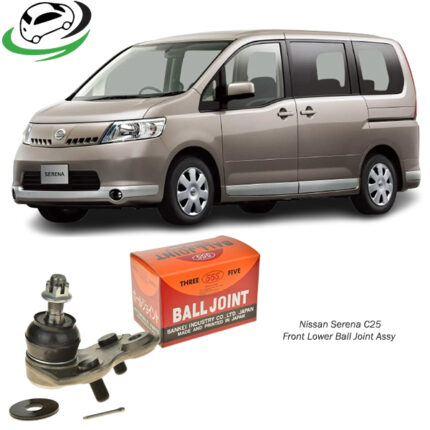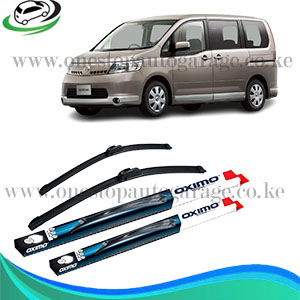-14%
Get Nissan Serena C25 Rack End SRN220 in Kenya
The rack end, also known as the inner tie rod, is an essential component of a vehicle’s steering system. It plays a crucial role in translating the motion of the steering wheel to the wheels, enabling precise control and maneuverability. Without a properly functioning rack end, the vehicle’s handling and safety can be significantly compromised.
In this detailed guide, we will cover the function, structure, benefits, maintenance, and potential issues associated with the rack end, as well as tips for identifying wear and replacing it.
What is a Rack End?
A rack end is a part of the steering assembly that connects the steering rack to the outer tie rod. Together, the rack ends and tie rods ensure that the wheels turn accurately in response to the driver’s input. They are located at either end of the steering rack and function as the intermediary between the rack-and-pinion steering mechanism and the wheels.
Structure of a Rack End
A typical rack end consists of the following components:
- Threaded Shaft:
- The threaded portion connects to the outer tie rod and allows for alignment adjustments.
- Ball and Socket Joint:
- Allows for pivoting movement to accommodate steering angles and suspension travel.
- Protective Boot (Steering Rack Boot):
- Covers the rack end and ball joint, shielding them from dirt, debris, and moisture.
- Attachment to Steering Rack:
- The opposite end of the rack end is securely mounted to the steering rack.
The materials used for rack ends are typically durable metals, such as steel or alloy, to withstand high stress and wear.
Function of the Rack End
The primary function of the rack end is to transfer steering input from the steering rack to the tie rods, which in turn move the wheels. Here’s how it works:
- Transmission of Motion:
- When the steering wheel is turned, the steering rack moves laterally.
- The rack ends transfer this motion to the tie rods.
- Adjustment for Suspension Movement:
- The ball-and-socket joint allows the rack end to pivot, accommodating the vertical movement of the suspension.
- Precision Control:
- Ensures that the steering input is accurately transmitted to the wheels, maintaining precise handling.
Benefits of a Properly Functioning Rack End
- Enhanced Steering Control:
- Provides a direct and responsive connection between the steering system and the wheels.
- Improved Vehicle Stability:
- Maintains alignment and ensures both wheels turn at the correct angles.
- Extended Component Lifespan:
- Protects other steering and suspension components by reducing stress and maintaining proper alignment.
- Safety Assurance:
- Prevents erratic steering and uneven wheel movement, reducing the risk of accidents.
- Smooth Driving Experience:
- Minimizes vibrations and ensures consistent steering performance.
Common Signs of a Failing Rack End
A failing rack end can compromise vehicle handling and safety. Here are some symptoms to watch for:
- Loose or Unstable Steering:
- Excessive play in the steering wheel or a “wandering” sensation while driving.
- Uneven Tire Wear:
- Misalignment caused by a faulty rack end can lead to rapid and uneven tread wear.
- Clunking or Knocking Sounds:
- Audible noises from the front end when turning or driving over bumps, often caused by worn joints.
- Steering Vibrations:
- Vibrations or wobbling felt through the steering wheel, especially at higher speeds.
- Difficulty in Steering:
- Increased effort required to turn the wheel, indicating a potential issue with the steering assembly.
Maintenance of Rack Ends
Proper maintenance of rack ends is essential to ensure optimal performance and longevity:
- Regular Inspection:
- Inspect the rack ends during routine maintenance or tire rotations for signs of wear or damage.
- Check Steering Rack Boots:
- Ensure that the protective boots are intact and free of cracks or tears to prevent contamination.
- Lubrication:
- For serviceable rack ends, ensure they are adequately lubricated to minimize friction.
- Alignment Checks:
- Regular wheel alignment ensures that the rack ends are functioning within their intended range of motion.
- Timely Replacement:
- Replace worn or damaged rack ends promptly to prevent further damage to the steering and suspension system.
Steps to Replace a Rack End
Tools Needed:
- Jack and jack stands
- Wrenches and sockets
- Tie rod puller or separator
- Torque wrench
- Replacement rack end
Step-by-Step Process:
- Lift the Vehicle:
- Secure the vehicle on a flat surface and use a jack to lift the front end.
- Support it with jack stands for safety.
- Remove the Wheel:
- Take off the front wheel to access the steering assembly.
- Detach the Tie Rod:
- Loosen the locking nut connecting the outer tie rod to the rack end.
- Use a tie rod puller to separate the outer tie rod from the steering knuckle.
- Remove the Rack End:
- Remove the steering rack boot to expose the rack end.
- Unscrew the rack end from the steering rack.
- Install the New Rack End:
- Attach the replacement rack end to the steering rack and tighten to the manufacturer’s specifications.
- Reassemble Components:
- Reinstall the steering rack boot and reconnect the outer tie rod.
- Secure the locking nut and check alignment.
- Alignment Adjustment:
- Perform a wheel alignment to ensure proper steering operation.
- Test Drive:
- Check the steering response and handling after replacement.
Common Issues with Rack Ends
- Wear and Tear:
- Continuous use leads to degradation of the ball-and-socket joint, reducing efficiency.
- Contamination:
- Dirt, debris, and moisture entering through damaged boots accelerate wear.
- Improper Installation:
- Misaligned or loosely fitted rack ends can cause handling issues and uneven tire wear.
- Corrosion:
- Rust and corrosion weaken the metal components, compromising structural integrity.
Importance of Quality Rack Ends
Investing in high-quality rack ends is crucial for:
- Longevity:
- Durable materials ensure extended service life.
- Performance:
- Superior quality components provide smoother and more responsive steering.
- Safety:
- Reliable rack ends reduce the risk of steering-related accidents.
Environmental Considerations
- Recycling Old Rack Ends:
- Ensure that old components are disposed of or recycled responsibly.
- Protective Boots:
- Use high-quality steering rack boots to reduce environmental contamination by grease or oil.
Conclusion
The rack end is an indispensable part of a vehicle’s steering system, contributing to precise control, stability, and safety. Regular inspection, proper maintenance, and timely replacement of worn rack ends ensure optimal performance and a smooth driving experience. By understanding its function and significance, vehicle owners can better care for this critical component and enhance their vehicle’s overall reliability.
Follow us on Facebook for more parts.



